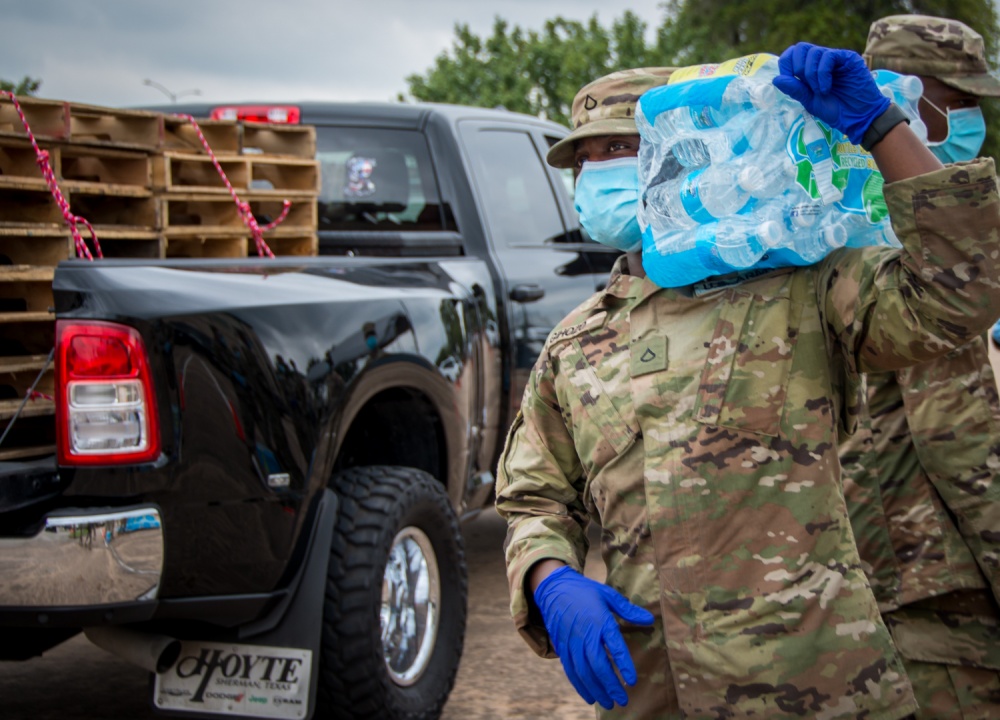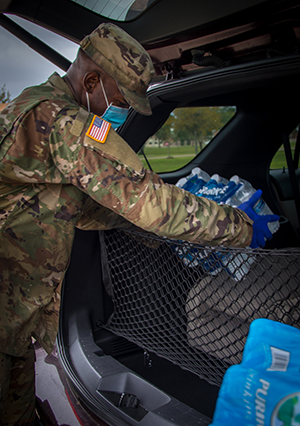 Photo By Master Sgt. Lynn M. Means | Texas Army National Guardsmen distribute water bottles to local residents October 8, 2020, at Lake Jackson, Texas. These Citizen Soldiers jumped into action to supply water to residents when a deadly amoeba affected their water supply. (Texas Air National Guard photo by Master Sgt. Lynn M. Means)
Photo By Master Sgt. Lynn M. Means | Texas Army National Guardsmen distribute water bottles to local residents October 8, 2020, at Lake Jackson, Texas. These Citizen Soldiers jumped into action to supply water to residents when a deadly amoeba affected their water supply. (Texas Air National Guard photo by Master Sgt. Lynn M. Means)
Story and photos by MSgt Lynn Means, 136th Airlift Wing, Texas Air National Guard
“We knew we were in a crisis.”
When the water supply of a southern Texas city became tainted and unsafe to drink, the Texas Military Department responded sending Army National Guardsmen to ensure residents had access to a supply of life sustaining water.
“Back in September, a little boy lost his life due to a brain eating amoeba,” said Bryan Sidebottom, deputy emergency manager for Lake Charles, Texas. “We were trying to figure out what happened, so we posted a water advisory. We told everyone the water was not consumable, and to use it only to flush the toilet.”
City officials were faced with the dilemma of ensuring residents had safe water to drink. Without the free flow of clean water to houses, it was going to be an enormous task.
“We didn’t have enough manpower in the city to hand out water bottles while we continued to provide city services,” said Sidebottom. “It’s a big task, so we requested the Guard.
“Initially we had a ‘do-not-use’ advisory for the city water, then it became a boil water advisory. This meant you could drink it after you boil the water.”
But this wasn’t the best solution, explained Sidebottom, because the elevated chlorine levels used to disinfect the system were still a great concern for residents.
“We wanted to ensure every citizen felt they were being taken care of,” said Sidebottom. “It’s been a very arduous task, but thankfully the Guard came to our aid.”
 Texas Army National Guardsmen distribute water bottles to local residents October 8, 2020, at Lake Jackson, Texas. These jumped into action to supply water to residents when a deadly amoeba affected the water supply. (Texas Air National Guard photo by Master Sgt. Lynn M. Means)
Texas Army National Guardsmen distribute water bottles to local residents October 8, 2020, at Lake Jackson, Texas. These jumped into action to supply water to residents when a deadly amoeba affected the water supply. (Texas Air National Guard photo by Master Sgt. Lynn M. Means)
Thirty-one Army National Guardsmen arrived early September 27, 2020, to quench Lake Jackson residents’ thirst. For nearly two weeks, the team handed out cases of water, talked to residents, and welcomed the opportunity to give service before self.
“Today we handed out 4,400 cases, hitting a little over one million water bottles since we started,” said Private 1st Class Markel Locks, a Texas Army National Guardsman assigned to the team. “Seeing people smile when we gave them water, it meant the world to us.
“It’s the reason I joined -- I wanted to help people.”
Locks said he was struck with the depth of this situation when the team had to move hotels because they couldn’t shower.
“We were a little scared,” said Locks. “Water is a part of life.”
But the outpouring of gratitude from residents had a positive reaction on the Citizen Soldiers.
“We all love being here,” said Locks. “Every four cars or so, we got cookies, candies, we got to look at all kinds of dogs - it was beautiful! I really love this town! I’ve been thinking about moving here.”
However, the mission was not without risk.
Several days into the mission, one Guardsman began experiencing symptoms of COVID-19.
“We had a Soldier experiencing symptoms and started asking about COVID,” said Army Capt. Juan Guerrero, 449th Aviation Support Battalion ammunition officer and officer in charge of the mission. “We took him to the hospital, then quarantined him at the hotel. Two days later, his test results came back positive.”
The team was taken off mission and waited in isolation to see if anyone else tested positive. The Texas Military Department immediately mustered a Quick Response Force to fill the mission’s needs.
“Within six hours’ notice, the QRF was out here,” said Guerrero. “It was really awesome. Next morning at 7 o’clock, they started [distributing water to residents], and kept it up for two days until we got our tests back."
The rest of the team was relieved to receive all negative results.
“We were ready to get back to work,” said Guerrero. “The city of Lake Jackson was a great host. They made sure we had hot meals and no need to eat MREs (Meals Ready to Eat). They really boosted our morale.”
Sidebottom explained the residents’ show of gratitude for the Citizen Soldiers who came to distribute water to their city.
“One resident wrote she could see everyone was happy to do what they were doing, and she could see that through their smiling eyes,” said Sidebottom, grinning behind his own mask.
He paused for a moment while his eyes welled up and he stood a little taller.
“She said it brought tears to her eyes to see their service,” he said. “I love that … it brings tears to my eyes just thinking about it.”
Sidebottom said it takes a special person to serve.
“They’re very high-spirited. They’re motivated. They understand the cause, and they’re always ready to serve."
They are Texans serving Texas.